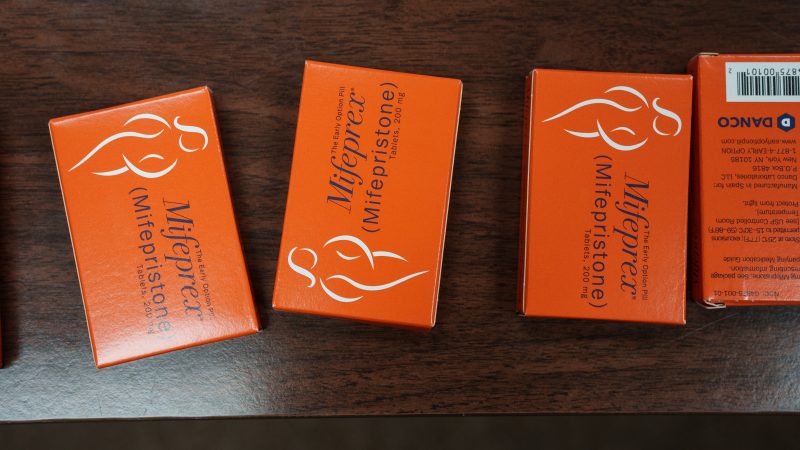A federal appeals court said Wednesday that it would restrict access to a widely used abortion medication after finding that the federal government did not follow the proper process when it loosened regulations in 2016 to make the pill more easily available.
Food and Drug Administration decisions to allow the drug mifepristone to be taken later in pregnancy, be mailed directly to patients and be prescribed by a medical professional other than a doctor were not lawful, a three-judge panel of the conservative U.S. Court of Appeals for the 5th Circuit ruled.
Mifepristone will remain available for now under existing regulations while the litigation continues, in accordance with a Supreme Court ruling this spring. The Justice Department said it will go to the Supreme Court to appeal Wednesday’s decision, which only partially upheld a lower-court judge’s ruling in favor of a coalition of antiabortion challengers.
If the Supreme Court allows the appeals court’s ruling to stand, the abortion pill would still be available in the United States, but it would be more difficult for patients to get it.
“In loosening mifepristone’s safety restrictions, FDA failed to address several important concerns about whether the drug would be safe for the women who use it,” Judge Jennifer Walker Elrod wrote in Wednesday’s opinion. “It failed to consider the cumulative effect of removing several important safeguards at the same time.”
How mifepristone is used
1/5
End of carousel
Erin Hawley, an attorney for the group that challenged mifepristone’s approval, said she was pleased with the court’s ruling even though she had argued that the drug should have never been approved in the first place.
Hawley said her team has not yet decided whether to appeal the part of the ruling that went against them. The Justice Department’s appeal, however, guarantees the high court will consider the issue.
“As the Attorney General has said before, the Justice Department is committed to defending the FDA’s scientific judgment and protecting Americans’ access to safe and effective reproductive care,” the Justice Department said in a statement. “The Department strongly disagrees with the Fifth Circuit’s decision in Alliance for Hippocratic Medicine v. FDA and will be seeking Supreme Court review of that decision.”
Mifepristone, which was first approved for use in this country more than 20 years ago is part of a two-drug regimen used in more than half of U.S. abortions. The legal battle over the medication has intensified since the Supreme Court overturned Roe v. Wade’s grant of a constitutional right to abortion in June 2022, a decision that spurred multiple states to further limit or ban the procedure.
The challenge to mifepristone was brought by the Alliance for Hippocratic Medicine, an association of antiabortion doctors and others. The group asserted that the FDA did not sufficiently consider safety concerns when it approved the drug in 2000 or when it removed some restrictions years later — allowing the use of mifepristone through 10 weeks of pregnancy, for instance, instead of seven.
The challengers had argued that the abortion pill should never have been approved and should be removed entirely from the market. They filed their lawsuit in Amarillo, Tex., where U.S. District Judge Matthew Kacsmaryk — a Trump nominee with long-held antiabortion views — is the sole sitting judge.
Kacsmaryk sided with the challengers and issued an unprecedented ruling in April, for the first time suspending FDA approval of a human drug over objections from the agency. His ruling embraced language used by antiabortion activists, referring to abortion providers as “abortionists” and to fetuses and embryos as “unborn humans.”
It was quickly put on hold so the federal government and the drug manufacturer could appeal.
Two of the three judges on the appeals court — Elrod and Cory T. Wilson — did not go as far as Kacsmaryk in their opinion Wednesday. They ruled that too much time has lapsed for the challengers to mount a court challenge to the FDA’s 2000 approval of mifepristone. Because that statute of limitations has passed, the judges did not address whether the FDA followed proper protocol when it originally approved the drug.
They did rule, however, that the agency years later did not properly vet whether the medication would still be safe if it is not administered in-person.
Where is abortion legal and illegal?
End of carousel
The Justice Department — which is representing the FDA — and the drug manufacturer Danco Laboratories, have emphasized the FDA’s reliance on dozens of studies involving thousands of patients to approve the medication, which has been used by more than 5 million women. Serious side effects occur in fewer than 1 percent of patients.
Lawyers defending the drug said the antiabortion challengers had no legal right — or standing — to file the lawsuit because they were not directly harmed by the FDA’s approval of the abortion pill. They also argued that allowing a court to revoke approval of an approved medication would jeopardize access to non-abortion drugs and more broadly harm medical research and innovation.
At oral argument in May, all three appeals court judges, who have previously supported abortion restrictions, seemed prepared to limit access to the medication.
Hawley, a lawyer for Alliance Defending Freedom — the law group representing the challengers — called the panel’s decision a victory for women’s health.
“The 5th Circuit rightly required the FDA to do its job and restore crucial safeguards for women and girls, including ending illegal mail-order abortions,” Hawley said in a statement.
The challengers also said in their lawsuit that the government should never have approved a generic version of mifepristone in 2019. But the appeals court said they did not have proper standing to challenge that decision, since they did not show that any of the doctors who joined the lawsuit were harmed by the generic version of the pill.
Wednesday’s ruling said the generic version of the medication should be subject to the same 2016 conditions as mifepristone.
The decision essentially echoed an earlier, initial review of Kacsmaryk’s opinion, in which a separate three-judge panel of the 5th Circuit declined to suspend approval of mifepristone but reversed actions taken by the FDA since 2016 to loosen restrictions.
The Supreme Court put that appeals court decision on hold while the litigation continues.
Judge James C. Ho dissented from part of Wednesday’s opinion, saying the statute of limitations for challenging the initial approval of mifepristone has not lapsed and the challengers have standing to contest it. Ho, an outspoken conservative and former clerk to Supreme Court Justice Clarence Thomas, wrote that he would have invalidated the FDA’s initial approval and believes the agency’s decisions are subject to review by the courts, just like decisions made by any other agency.
“The scientists at the FDA deserve our respect and our gratitude, but not our blind deference,” Ho wrote.
A rollback to 2016 regulations would dramatically change how women access the abortion pill in this country, said Greer Donley, an associate professor at the University of Pittsburgh School of Law, noting in particular the potential restriction of the medication to the first seven weeks of pregnancy.
“This is an example where the Fifth Circuit seems to be really second-guessing the FDA’s decision,” she said.



























